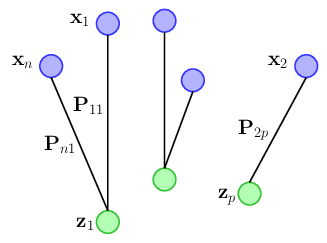The repository implements the Optimal Transport Kernel Embedding (OTKE) described in the following paper
Grégoire Mialon*, Dexiong Chen*, Alexandre d'Aspremont, Julien Mairal. A Trainable Optimal Transport Embedding for Feature Aggregation and its Relationship to Attention. ICLR 2021.
*Equal contribution
TLDR; the paper demonstrates the advantage of our OTK Embedding over usual aggregation methods (e.g, mean pooling, max pooling or attention) when faced with data composed of large sets of features, such as biological sequences, natural language sentences or even images. Our embedding can be learned either with or without labels, which is especially useful when few annotated data are available, and used alone as a kernel method or as a layer in larger models.
The principal module is implemented in otk/layers.py as OTKernel. It is generally used with a non-linear layer. Combined with the non-linear layer, it takes a sequence or image tensor as input, and performs a non-linear embedding and an adaptive pooling (attention + pooling) based on optimal transport. Specifically, given a sequence x as input, it first computes the optimal transport plan from x to some reference z (left figure). The optimal transport plan, interpreted as the attention score, is then used to obtain a new sequence of the same size as z following a non-linear mapping (right figure). See more details in our paper.
OTKernel can be trained in either unsupervised (with K-means) or supervised (like the multi-head self-attention module in Transformer) fashions. It can be used as a module in neural networks, or alone as a kernel method.
Here is an example to use OTKernel in a one-layer model
import torch
from torch import nn
from otk.layers import OTKernel
in_dim = 128
hidden_size = 64
# create an OTK model with single reference and 10 supports
otk_layer = nn.Sequential(
nn.Linear(in_dim, hidden_size),
nn.ReLU(),
OTKernel(in_dim=hidden_size, out_size=10, heads=1)
)
# create 2 batches of sequences of L=100 and dim=128
input = torch.rand(2, 100, in_dim)
# each output sequence has L=10 and dim=64
output = otk_layer(input) # 2 x 10 x 64When using OTKernel alone, the non-linear mapping is a Gaussian kernel (or a convolutional kernel). The full model for sequence is implemented in otk/models.py as SeqAttention. Here is an example
import torch
from otk.models import SeqAttention
in_dim = 128
hidden_size = 64
nclass = 10
# create a classification model based on one CKN and OTK, with filter_size=1 and sigma=0.6 for CKN and with 4 references and 10 supports for OTK
otk_model = SeqAttention(
in_dim, nclass, [hidden_size], [1], [1], [0.6], out_size=10, heads=4
)
# create 2 batches of sequences of L=100 and dim=128
input = torch.rand(2, in_dim, 100)
# output: 2 x 10
output = otk_model(input)Besides training with back-propagation, the above otk_model can be trained without supervision when provided with a data_loader object created by torch.utils.data.DataLoader.
from torch.utils.data import DataLoader
# suppose that we have stored data in dataset
data_loader = DataLoader(dataset, batch_size=256, shuffle=False)
otk_model.unsup_train(data_loader)We strongly recommend users to use miniconda to install the following packages (link to pytorch)
python=3.6
numpy
scikit-learn
pytorch=1.4.0
pandas
Then run
export PYTHONPATH=$PWD:$PYTHONPATHWe provide here the commands to reproduce a part of the results in our paper.
To reproduce the results in Table 2, run the following commands.
-
Data preparation
cd data bash get_scop.sh -
Unsupervised learning with OTK for SCOP 1.75
cd experiments python scop175_unsup.py --n-filters 512 --out-size 100 --eps 0.5 -
Supervised learning with OTK for SCOP 1.75
cd experiments # OTK with one reference python scop175_sup.py --n-filters 512 --heads 1 --out-size 50 --alternating # OTK with multiple references python scop175_sup.py --n-filters 512 --heads 5 --out-size 10 --alternating
To reproduce the results (auROC=0.936, auPRC=0.360) in Table 3, run the following commands.
-
Data preparation
cd data bash get_deepsea.sh -
Evaluating our pretrained model
Download our pretrained model to
./logs_deepseaand then runcd experiments python eval_deepsea.py --eps 1.0 --heads 1 --out-size 64 --hidden-layer --position-encoding gaussian --weight-decay 1e-06 --position-sigma 0.1 --outdir ../logs_deepsea --max-iter 30 --filter-size 16 --hidden-size 1536 -
Training and Evaluating a new model
First train a model with the following commands
cd experiments python train_deepsea.py --eps 1.0 --heads 1 --out-size 64 --hidden-layer --position-encoding gaussian --weight-decay 1e-06 --position-sigma 0.1 --outdir ../logs_deepsea --max-iter 30 --filter-size 16 --hidden-size 1536Once the model is trained, run
python eval_deepsea.py --eps 1.0 --heads 1 --out-size 64 --hidden-layer --position-encoding gaussian --weight-decay 1e-06 --position-sigma 0.1 --outdir ../logs_deepsea --max-iter 30 --filter-size 16 --hidden-size 1536
To reproduce the results in Table 4, run the following commands.
-
Data preparation
cd data bash get_sst2.sh -
Unsupervised learning with OTK for SST-2
cd experiments python nlp_unsup.py --n-filters 2048 --out-size 3 -
Supervised learning with OTK for SST-2
cd experiments # OTK with one reference python nlp_sup.py --n-filters 64 --out-size 3 --eps 3.0 --alternating

